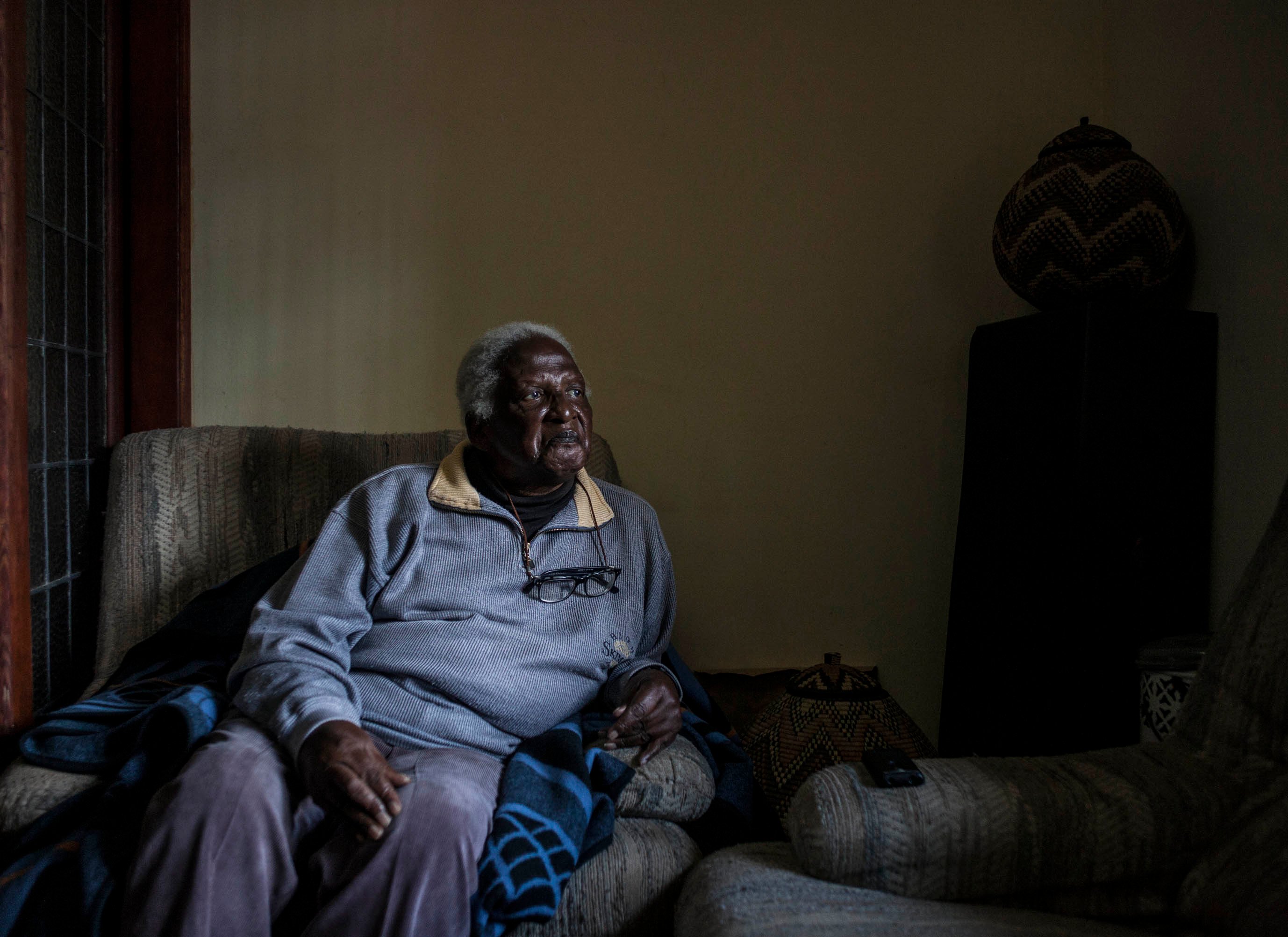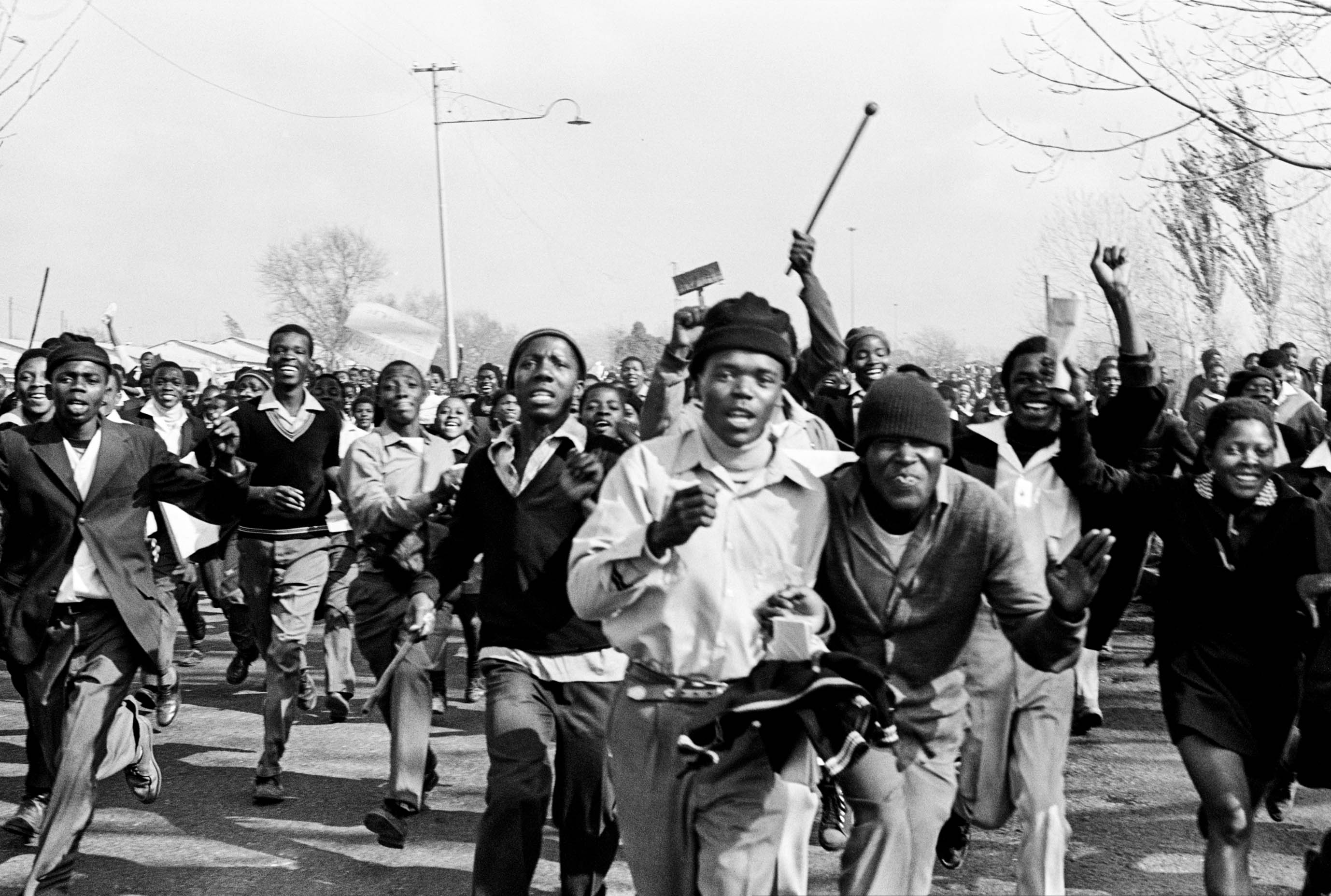[Antoinette Sithole at her brother’s funeral
A huge, framed photographic collage dominates a wall in the lounge of Peter Magubane’s house. It looms large, to the right of the photographer, who is sitting in his favourite chair.
The main image is a black-and-white portrait of the man (face askew and nose cracked crooked) in a polo neck and corduroy jacket. A Nikon camera dangles from his neck. From the logos and inscriptions adorning the image, one can deduce that it honours the 40th anniversary of Magubane’s participation in the uprisings that spread throughout the country after June 16 1976.
“A policeman hit me across my face with a baton [in Alexandra on June 17],” he says when asked about it. “The police were very furious there.”
At the age of 86, it is perhaps to be expected, and in some ways poetic, that the veteran photographer’s photographs have come to stand in for his memory. In conversation, he downplays or rejects stories about his heroics and infamous stealth.
In the 2006 biographical documentary 1976 — Finger on the Trigger, Magubane says that, after a five-year banning order and a 586-day stint in solitary confinement, he went into June ’76 like a wounded tiger. “I had not been working as a newspaper person for seven years,” he says in the film (produced by Kevin Harris, directed by Zingi Mkefa and Guy Hubbard), “especially after what I did in Sharpeville [in March 1960]. I said, ‘There is no one that is going to move me from here.’”
In Sharpeville, witnessing the scores slain and many more lying injured, Magubane was overcome by emotion and kept his distance from the carnage. Later, his editor at Drum at the time advised him to keep his emotions in check, at least until after the job at hand.
Hence the “wounded tiger” that attacked 1976 with unwavering determination.
The photographs from that month, captured in several volumes, embody this change in character. There is a book marking the 24th anniversary of 1976, its cover bearing a throng of youth descending on Magubane with a mixture of enacted and actual rage. Inside, there is an image of, eyes downcast, or perhaps even closed. Dressed in black, she strikes a Black Power salute, her head framed by a giant, halo-like wreath carried by a mourner obscured behind Sithole’s frame. A few pages before, there is an image of the charred, skeletal remains of a truck driver, the metallic remnants of his vehicle dangling overhead.

[Experienced: Magubane (86) may have mellowed but is certainly not resting on his laurels. Photo: Oupa Nkosi]
Although the singular image of that day would be captured by Sam Nzima, who died last week, on May 12, what one sees in Magubane’s work during that massacre is a panoramic view of the human toll. There are corpses lying lifeless, limbs peeking through newspapers meant to respectfully obscure the dead. A woman grimaces, baring her bullet-streaked torso while her companion steadies her pain-riddled gait.
The immediacy of the images and the tumult of the situation are captured by the varying strains of focus, in some cases a sliver of a dashboard in the frame’s bottom end alluding to the covertness at play.
To say Magubane shot the daylights out of 1976 is now a fact borne out by the number of editions that exist as a document of his photographs from that year, with a voluminous 40th-anniversary version being released by Seriti sa Sechaba publishers two years ago. Fellow photographers, though, take his heroics into the realm of folklore.
“When that Nzima pic was going around,” says Cape Town-based lensman Fanie Jason, “many people thought it was Peter’s pic. Such was his ability to get the picture. He’s a good documentarian. No matter what happened he stayed with the story.”
In 1976 — Finger on the Trigger, Raymond Louw, a former editor at the Rand Daily Mail (where Magubane worked from the 1960s), remembers him as an unsociable fellow in the newsroom, dubbing him “a loner”.
It is a characterisation with which photographer Rashid Lombard, who encountered him several times in the field, only partially agrees. “From a distance he was a loner,” says Lombard. “I have a personal experience where he was very open. He was a loner because he had to capture a certain mood and angle for his assignments. Whereas during my period with AFP [Agence France-Presse], they wanted everything that’s violent and bloody, his assignments were on a documentary basis as opposed to one pic for the front page. There, you find a new eye, a new angle. You go out on your own.”
Jason and Lombard consider the aloofness often ascribed to Magubane as part of his shrewdness as a photographer. “He worked for Time magazine when Time was top-notch,” says Jason. “He was one of the richest photographers in South Africa. When I was getting R80 a pic, he was getting R1 500 a picture. He made it look like we were living on child income grants. He was a very smart guy who knew how to market himself.

[Scrupulous: Peter Magubane shot the daylights out of the 1976 Soweto uprising, capturing with his toil both the tumult of the situation and a panoramic view of the human toll (Peter Magubane)]
“He was one of the only black photographers in Africa to have a body of work for National Geographic, for his work on amaNdebele. Those guys would give you $350 000 for a six-month assignment and they would only want 14 pictures out of that. I remember trying to sell a body of work to them and they said, ‘This was quick. You didn’t spend a lot of time’, and it was true.”
Lombard reflects on Magubane as someone who would often impart skills to photographers he met on the job. “At some point he was shooting out of two or three cameras, one colour and two black-and-white. “He taught me a lot about exposure and that kind of thing because one [colour] functions almost as an opposite to the other [black-and-white].”
The abandon with which Magubane has thrown himself into his practice, no matter the subject, has been with such force as to obscure any definitive inquiry into his politics. In the 1980s, Magubane embarked on a project to document Afrikaners in the town of Parys. He shelved the project, nervous energy rendering his subjects nameless.
He only revived it in this current decade, when he was going through his archives to digitise his collection of photographs. Again, he attacked it with the gusto that has become a familiar feature when appraising his output. The images, taken from Ventersdorp to Groot Marico and the Klein Karoo Nasionale Kunstefees, capture Afrikaners without the stigma and stench of apartheid shrouding their auras.
Writing about the collection, which Magubane hopes to compile into a book, Percy Mabandu mused about the “Mandelaesque” nature of the entire endeavour. It is a nifty phrase but it is Magubane’s quotes that shimmer off the page. “If you don’t forgive, your profession will suffer,” the master imagemaker says. “Besides, I deal with people. It doesn’t matter if they are wrong or right. I have to deal with them as people.”
It is photographer Cedric Nunn, a self-described “toppie”, who holds my hand through the mercurial slipstream that is Magubane’s view of the world. “Whatever you think of him as a person, you can’t fault his work ethic,” says Nunn, his voice crackling from somewhere in the hills of KwaZulu-Natal’s Midlands. When people reach a certain age, we might say they mellow out but there’s a wisdom that comes with age and it might not be as fiery and radical as Peter Magubane at 35.
“He’s seen a lot,” continues Nunn. “He was there in Sharpeville, where his editor was harshly critical of his photography at that moment and he learnt so much from it. But he’s also seen changes, not just in South Africa but globally. He’s got a perspective that we don’t have. Mandela was one such youth who rebelled against his elders and took the organisation [the ANC] to war. Don’t we say he reconciled too much? But I would never wish a Syria or an Iraq on our country. But you see, you need a certain wisdom to avert that. And maybe that’s the price we are paying now.”
As for Magubane, it is on to the next image, be it a sunset (his current fascination) or a brewer at a mampoer festival. Whatever it is, it is bound to be an image to keep us pondering until the end of history.